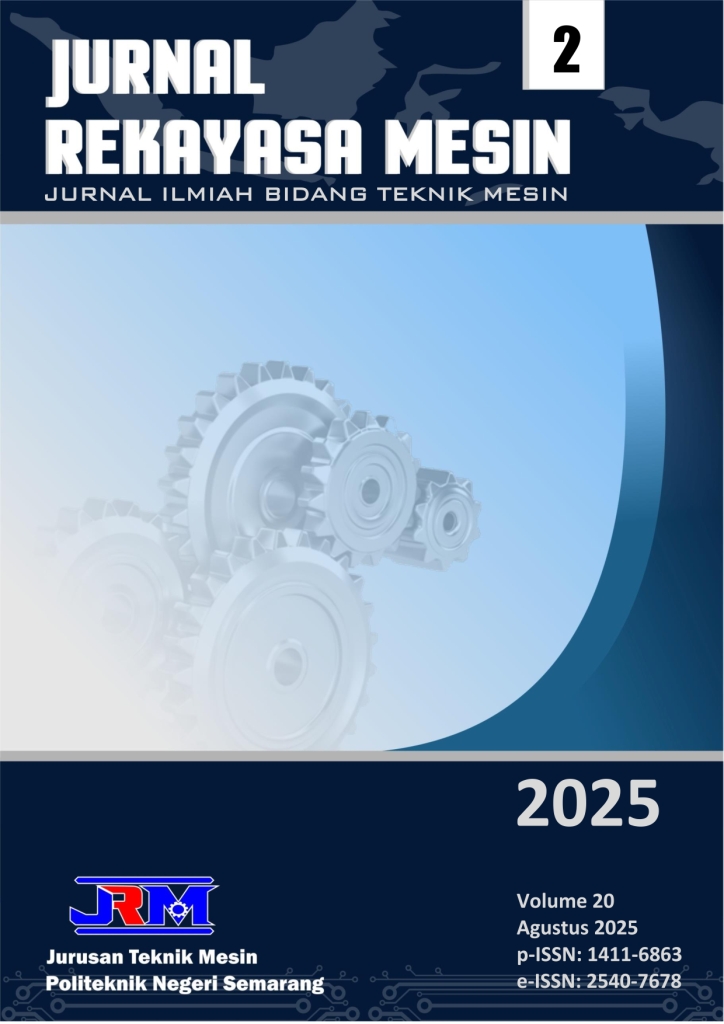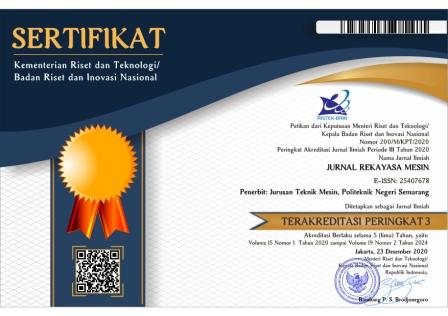Numerical Study of EV Frame Performance in Side Pole Collision: ASTM A36 vs. AL-7075T6 Analysis
DOI:
https://doi.org/10.32497/jrm.v20i2.6438Keywords:
electric vehicles, side-pole crash test, finite element analysis, crashworthiness, structural safetyAbstract
Electric vehicles are emerging as eco-friendly alternatives to reduce greenhouse gas emissions and combat global warming. The Indonesian government supports this transition through subsidies, infrastructure development, and regulations encouraging electric vehicle adoption. Automotive manufacturers are enhancing electric vehicle models with safer and more efficient technology. Ensuring the frame's durability during collisions is crucial for safety. Structural engineering plays a vital role, as material failure from operational loads or impacts can lead to significant losses. The large and heavy batteries in electric vehicles present challenges in designing frames that support loads while maintaining passenger safety. Side-pole crash testing is essential due to the limited crumple zones on vehicle sides. This study analyzed the performance of ASTM A36 and AL-7075T6 materials in a side-pole collision at 32 km/h speed using the Finite Element Analysis method. The results showed that both materials experienced almost the same deformation, 98.79 mm for ASTM A26 and 98.77 mm for AL-7075T6. It is, however, a large difference in the maximum stress, ASTM A36 at 4849.7 MPa, and AL-7075T6 at only 1699.9 MPa. This was shown that AL-7075T6 has a better impact resistance than ASTM A36, therefore increasing the safety of electric vehicle frames for side-pole collision conditions.
References
[1] R. Hidayat and J. Cowie, “A framework to explore policy to support the adoption of electric vehicles in developing nations: A case study of Indonesia,” Transp. Res. Procedia, vol. 70, pp. 364–371, 2023, doi: 10.1016/j.trpro.2023.11.041.
[2] N. C. Kresnanto and W. H. Putri, “Subsidies for electric vehicles as a form of green transportation: Evidence from Indonesia,” Transp. Res. Interdiscip. Perspect., vol. 27, February, p. 101230, 2024, doi: 10.1016/j.trip.2024.101230.
[3] R. T. Yadlapalli, A. Kotapati, R. Kandipati, and C. S. Koritala, “A review on energy efficient technologies for electric vehicle applications,” J. Energy Storage, vol. 50, no. January, p. 104212, 2022, doi: 10.1016/j.est.2022.104212.
[4] U. Idrees et al., “Finite element analysis of car frame frontal crash using lightweight materials,” J. Eng. Res., vol. 11, no. 1, 2023, doi: 10.1016/j.jer.2023.100007.
[5] A. Fajri, A. R. Prabowo, N. Muhayat, D. F. Smaradhana, and A. Bahatmaka, “Fatigue analysis of engineering structures: State of development and achievement,” Procedia Struct. Integr., vol. 33, no. C, pp. 19–26, 2021, doi: 10.1016/j.prostr.2021.10.004.
[6] A. R. Prabowo, A. Bahatmaka, and J. M. Sohn, “Crashworthiness characteristic of longitudinal deck structures against identified accidental action in marine environment: a study case of ship–bow collision,” J. Brazilian Soc. Mech. Sci. Eng., vol. 42, no. 11, pp. 1–13, 2020, doi: 10.1007/s40430-020-02662-2.
[7] E. Cebe, O. Kalbaran, and A. B. Irez, “A numerical investigation of ground impact for hierarchically designed hybrid composite structures in electric vehicle battery cases,” J. Power Sources, vol. 638, no. December 2024, p. 236594, 2025, doi: 10.1016/j.jpowsour.2025.236594.
[8] X. Zhu, W. Wang, W. Li, Q. Zhang, G. Lei, and Q. X. Wu, “Impact resistance of bridge columns with energy-absorbing crash dampers under vehicle collisions,” J. Constr. Steel Res., vol. 218, no. April, p. 108740, 2024, doi: 10.1016/j.jcsr.2024.108740.
[9] A. B. Navale, S. P. Chippa, D. A. Chougule, and P. M. Raut, “Crashworthiness aspects of electric vehicle design,” Int. J. Crashworthiness, vol. 26, no. 4, pp. 368–387, 2021, doi: 10.1080/13588265.2020.1718462.
[10] R. Yang, S. Li, T. Cheng, P. Zou, and L. Tian, “Enhanced Side Pole Impact Protection: Crashworthiness Optimization for Electric Micro Commercial Vehicles,” Appl. Sci., vol. 15, no. 4, 2025, doi: 10.3390/app15042220.
[11] A. Gashu and R. B. Nallamothu, “Improvement of crashworthiness of pickup vehicle for frontal and side collision using Finite Element analysis,” Adv. Mech. Eng., vol. 17, no. 2, pp. 1–16, 2025, doi: 10.1177/16878132251322029.
[12] Z. Hongxue, W. Sanxia, L. Xiao, P. Zhifei, and Z. Guosheng, “Optimization for Side Structure of Vehicle Based on FEA,” Procedia Comput. Sci., vol. 208, pp. 196–205, 2022, doi: 10.1016/j.procs.2022.10.029.
[13] S. Malaimeham and S. Vinaitheerthan, “Performance improvement of steel and aluminum crush box with mass optimization by using finite element method,” Rev. Mater., vol. 29, no. 4, 2024, doi: 10.1590/1517-7076-RMAT-2024-0568.
[14] A. Verma et al., “Finite element analysis and its application in Orthopaedics: A narrative review,” J. Clin. Orthop. Trauma, vol. 58, no. November, p. 102803, 2024, doi: 10.1016/j.jcot.2024.102803.
[15] R. P. Putra et al., “Design and Crash Test on a Two-Passenger City Car Frame using the Finite Element Method,” Automot. Exp., vol. 7, no. 2, pp. 270–283, 2024, doi: 10.31603/ae.11306.
[16] C. M. Choudhari, J. Desai, S. Bhavsar, and D. Choudhary, Crash simulation of an Automotive Body to Explore Performance of Different Metallic Materials using ANSYS. Springer Singapore, 2019. doi: 10.1007/978-981-13-2490-1_64.
[17] T. Oktay and Y. Eraslan, “Mesh Independence Study On Computational Fluid Dynamics (CFD) Analysis of A Quad-Rotor Uav Propeller,” 3 . Int. Eur. Conf. Interdiscip. Sci. Res., no. 1, 2021.
[18] M. Alardhi, R. Sequeira, M. Fahed, J. Alrajhi, and K. Alkhulaifi, “applied sciences Assessing the Crashworthiness Analysis on Frontal and Corner Impacts of Vehicle on Street Poles Using FEA,” 2022.
[19] P. Kaczynski, “Crashworthiness Characteristic of Dynamically Expanded Circular Tubes Made of Light Alloys :,” 2020, doi: 10.3390/ma13235332.
Downloads
Published
How to Cite
Issue
Section
License
Copyright (c) 2025 Mukhlis Amin, Aldias Bahatmaka Bahatmaka

This work is licensed under a Creative Commons Attribution-NonCommercial-ShareAlike 4.0 International License.
Copyright of articles that appear in Jurnal Rekayasa Mesin belongs exclusively to Penerbit Jurusan Teknik Mesin Politeknik Negeri Semarang. This copyright covers the rights to reproduce the article, including reprints, electronic reproductions, or any other reproductions of similar nature.







